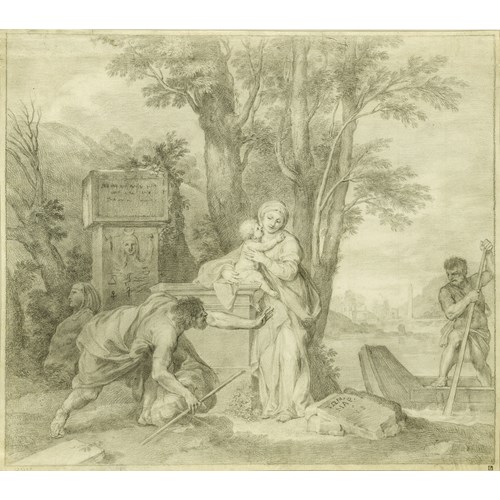Marketplace
Architectural Ruin with a Crowd
Joost Cornelisz Droochsloot
Architectural Ruin with a Crowd
Period 1600-1750, 17th century
Origin The Netherlands
Medium Oil on panel
Dimension 36 x 57 cm (14¹/₈ x 22¹/₂ inches)
This crowded painting provides a plethora of detail to absorb the viewer. Milling around a street flanked by classical architecture and overgrown with foliage, stand a number of impoverished figures. Several characters stand out - the two men, whose gaunt bodies are covered only by a few rags, the mother who clutches her baby to her breast whilst another grubby child clings to her arm and the man who hobbles along on crutches. The legless man in the centre of the composition, who uses two blocks to help drag himself through the dusty town, is a recurrent motif in Droochsloot’s work. Throughout the painting the figures look dishevelled and destitute.
The significant exception to this is the figure dressed in a pink cloak, standing on the plinth on the right-hand side. His elevation above the street immediately sets him apart from those in the street below, as does the relative luxury of his clothing and his upright and confident pose. The soldier standing nearby adds to the impression that the turbaned man is one of authority and power. Various figures point up towards the plinth further drawing attention to this grouping.
The majority of Droochsloot’s paintings depict scenes which are crowded with figures, for instance, the Hermitage’s Rural Feast. In Rural Feast, as in the present work, Droochsloot has individualised each one of his figures, treating them each with careful attention. There is a considerable variety amongst the groups that make up this scene of rustic celebration. Perhaps the most eye-catching of the peasants is the figure that stands up in the boat, arms outstretched.
Despite compositional similarities, the mood of these scenes varies dramatically, a reflection of Droochsloot’s work as a whole. As well as humble scenes of happy village life he also employed similar backdrops for paintings which depicted extreme violence and often featured plundering soldiers. Paintings such as the present work however ‘evince real sympathy for the poor and oppressed’ and are at the core of his oeuvre.¹ In the Rijksmuseum’s St. Martin Cutting off Part of his Cloak for a Beggar, Droochsloot has actually portrayed a violent beating on the left-hand side, whilst on the right-hand side we see portraits of poverty and helplessness, which are reminiscent of some of those in the present work. Once more, every figure reflects deliberation and thought on the part of the artist, and their individuality and detail engrosses the viewer.
Droochsloot was a versatile painter, whose work reflects the influence of artists such as David Vinckboons (1576-1633). He worked in Utrecht all his life, was dean of the Guild of St. Luke several times, and was also regent of the St. John’s hospital, to which he donated appropriate pictures.
Professor A. Mayer, formerly of the Alte Pinakothek, Munich provided expertise in relation to this painting, 5 May, 1930.
¹ Kunzle, D., From Criminal to Courtier: the Soldier in Netherlandish Art, 1550-1672, (Brill, 2002), p. 328.
The significant exception to this is the figure dressed in a pink cloak, standing on the plinth on the right-hand side. His elevation above the street immediately sets him apart from those in the street below, as does the relative luxury of his clothing and his upright and confident pose. The soldier standing nearby adds to the impression that the turbaned man is one of authority and power. Various figures point up towards the plinth further drawing attention to this grouping.
The majority of Droochsloot’s paintings depict scenes which are crowded with figures, for instance, the Hermitage’s Rural Feast. In Rural Feast, as in the present work, Droochsloot has individualised each one of his figures, treating them each with careful attention. There is a considerable variety amongst the groups that make up this scene of rustic celebration. Perhaps the most eye-catching of the peasants is the figure that stands up in the boat, arms outstretched.
Despite compositional similarities, the mood of these scenes varies dramatically, a reflection of Droochsloot’s work as a whole. As well as humble scenes of happy village life he also employed similar backdrops for paintings which depicted extreme violence and often featured plundering soldiers. Paintings such as the present work however ‘evince real sympathy for the poor and oppressed’ and are at the core of his oeuvre.¹ In the Rijksmuseum’s St. Martin Cutting off Part of his Cloak for a Beggar, Droochsloot has actually portrayed a violent beating on the left-hand side, whilst on the right-hand side we see portraits of poverty and helplessness, which are reminiscent of some of those in the present work. Once more, every figure reflects deliberation and thought on the part of the artist, and their individuality and detail engrosses the viewer.
Droochsloot was a versatile painter, whose work reflects the influence of artists such as David Vinckboons (1576-1633). He worked in Utrecht all his life, was dean of the Guild of St. Luke several times, and was also regent of the St. John’s hospital, to which he donated appropriate pictures.
Professor A. Mayer, formerly of the Alte Pinakothek, Munich provided expertise in relation to this painting, 5 May, 1930.
¹ Kunzle, D., From Criminal to Courtier: the Soldier in Netherlandish Art, 1550-1672, (Brill, 2002), p. 328.
Period: 1600-1750, 17th century
Origin: The Netherlands
Medium: Oil on panel
Signature: Signed ‘JC Droochsloot’ (lower left).
Dimension: 36 x 57 cm (14¹/₈ x 22¹/₂ inches)
Provenance: Collection of M. Crabtree, 19th Century London, nr. 113.
More artworks from the Gallery









